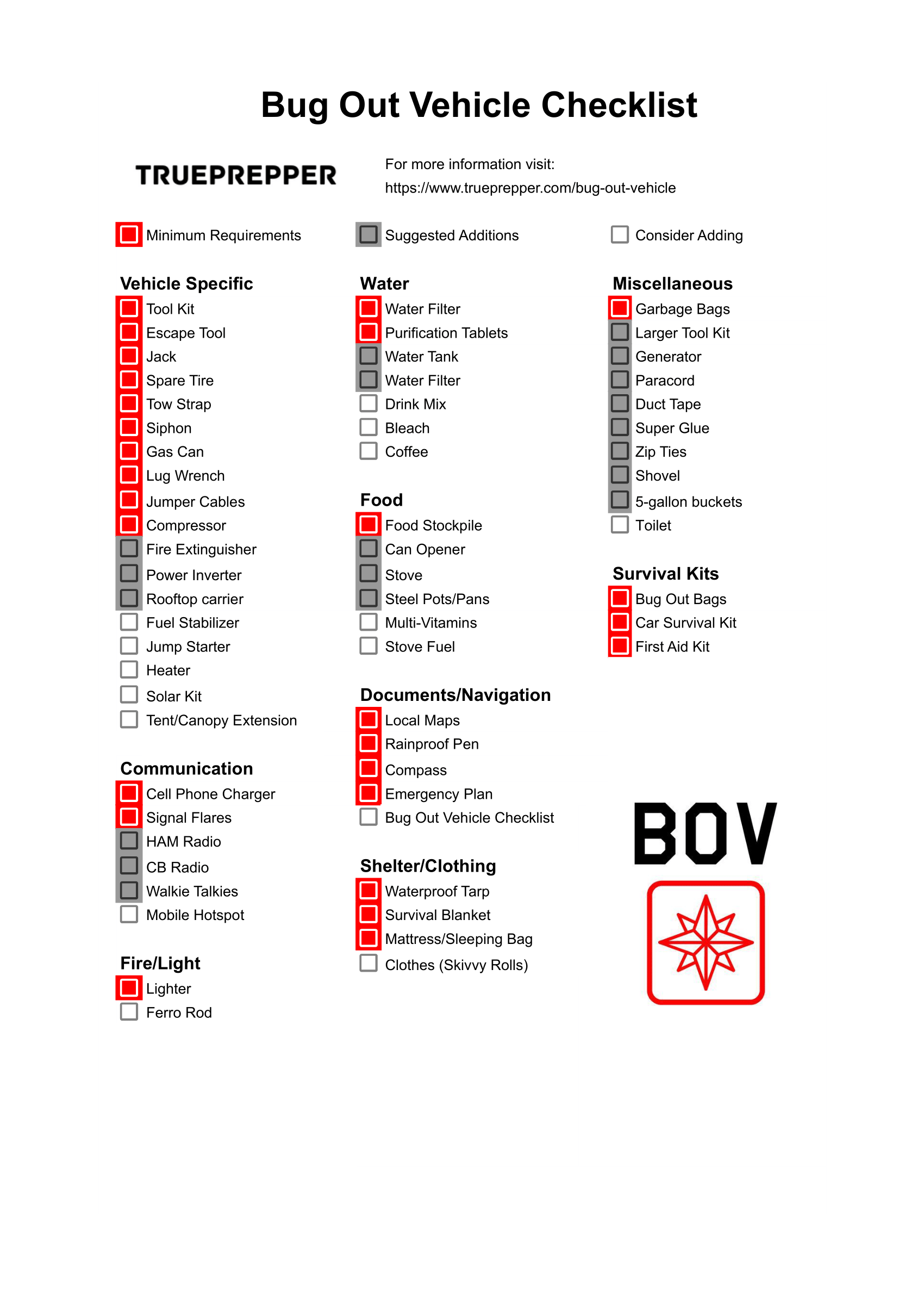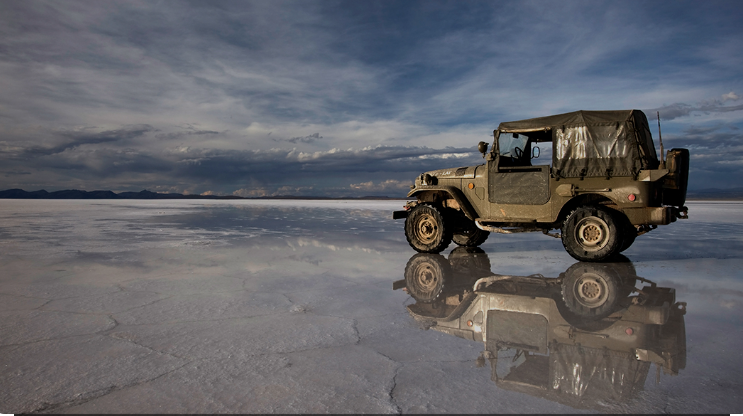Bug Out Vehicle Guide, Gear List, and Checklist
A bug out vehicle, also known as a BOV or survival vehicle, is a vehicle that is designed to help its occupants quickly evacuate an area in the event of an emergency or disaster. BOVs typically have a number of features that make them well-suited for this purpose, such as large storage capacity, off-road capabilities, and durability.
In this article we will take a closer look at some specific bug out vehicles, key features to consider when choosing one, and a common checklist to gear it up and get it going.
What is a Bug Out Vehicle
A bug out vehicle (BOV) is a type of vehicle that is specifically designed to help its occupants quickly and safely evacuate an area in the event of an emergency or disaster. This could be anything from a natural disaster like a hurricane or earthquake to a man-made disaster like a terrorist attack or civil unrest.
The goal of a BOV is to provide its occupants with a means of transportation that is reliable, durable, and capable of handling a variety of different terrains and road conditions. BOVs are typically larger and more rugged than the average passenger vehicle and are often equipped with a number of specialized features that make them well-suited for emergency situations.
Features of a BOV
One of the key features of a bug out vehicle is its storage capacity. BOVs are designed to be able to carry large amounts of gear and supplies, which can be essential in an emergency situation. This could include things like food, water, medical supplies, tools, and other essential items.
Another important consideration for a BOV is its off-road capabilities. In an emergency situation, it is likely that roads and highways will be congested, damaged, or blocked, making it necessary to take alternative routes. A BOV should be able to handle a variety of different terrains, including dirt roads, muddy trails, and rocky terrain.
In addition to its storage capacity and off-road capabilities, a BOV should also be durable and reliable. In an emergency situation, there may not be the option to call for help or to get roadside assistance. Ideally, a BOV should be able to withstand rough treatment and should be able to continue running even if it sustains damage.
Types of Bug Out Vehicles
There are a number of different types of bug out vehicles to choose from, each with its own unique set of features and capabilities.
The most common types of BOVs include:
- Sport Utility Vehicles: SUVs are popular choices for BOVs due to their combination of size, storage capacity, and off-road capabilities. Many SUVs are also equipped with four-wheel drive, which can be essential for navigating rough terrain.
- Pickup Trucks: Pickup trucks are another popular choice for BOVs, due to their large storage capacity and off-road capabilities. Many pickup trucks are also equipped with four-wheel drive, which can be useful in emergency situations.
- Vans: Vans can be a good choice for BOVs due to their large storage capacity and ability to transport multiple people. Some vans are also equipped with four-wheel drive, which can be useful in off-road situations. Check out our entire guide on Bug Out Vans.
- Military Vehicles: Military vehicles are designed to be rugged and durable, making them well-suited for use as BOVs. Some popular choices include the Humvee and the MRAP.
- Recreation Vehicles (RVs): RVs come in a wide range of sizes and with a wide range of options. Being mobile homes on wheels makes them a solid choice for living on the go, even in an emergency. Some plan on an RV being both the bug out vehicle and the bug out location.
Regardless of the type, having a vehicle ready is a smart part of your overall bug out plan.
Other BOVs
Less common bug out vehicles can make sense for specific situations. Here are the options preppers have explored:
- Aircraft: On the pricey side of things, any type of aircraft can get you to your bug out location quickly.
- Boats: Like aircraft, boat travel can be restrictive but is much more affordable. If you are near the coast or a body of water, a boat could be a good vehicle option. With the variety available some preppers plan on using these:
- House Boat: These sustainability barges can be pretty comfortable as a secluded bug out location when they are built out properly.
- Collapsible Boats: Inflatable John boats and foldable kayaks are the go-to here, for people near water but don’t want the maintenance and responsibilities of owning a boat with an actual hull.
- Bikes: A popular bug out vehicle for urban areas also works quite well in grid-down or EMP situations. With saddlebags and/or trailers you can take a lot of equipment with you as well. Bikes can maneuver where cars cannot and are sustainably human-powered so gas or electricity does not have to be an issue.
- Motorcycles: Many times, carburated motorcycles are picked as bug out vehicles because of EMP resiliency and a motorcycle’s ability to maneuver between gridlocked traffic.
- Sedans: Cars are not the best pick for a bug out vehicle, but if it’s what you have you can make it work.
Bug Out Trailers
Having your bug out vehicle as a daily driver can be cumbersome, so some preppers opt to offload their gear into a bug out trailer. When they need to bug out they hook up the trailer which is smart and quick.
No need to pack up tons of bags and bins- it’s all preloaded. Plus, this lets you declutter your actual vehicle for everyday use. Bug out trailers make a lot of sense the more you think about it.
Bug Out Electric Vehicles (EVs)
This is one I’m personally planning out with a Tesla Model 3. There are many drawbacks to using an EV as a bug out vehicle (range, off-road capability) but they have some under-sold benefits as well. In my family, we could bug out both the EV and the SUV, but if we bug in (stay in place)- which we are more than prepared to do- the Tesla becomes a massive battery pack.
The base Model 3 I have has a 60 kWh 106 cell 400V Lithium Ion pack in it ready to power whatever when I put the vehicle in ‘camp mode’. Tesla discourages using it as a ‘stationary power source’ and voids the warranty if they find out but other EV manufacturers have been touting their ability to power odds and ends.
EVs also can be charged with any electrical source: from solar panels to dual fuel generators. Combustion cars have to seek out or store gasoline or diesel, whereas electricity is much easier to come by in the modern world.
The last drawback to EVs is the threat of an EMP. EMPs would disable many modern cars, but an EV is guaranteed to be a paperweight. I’ve considered constructing a giant Faraday bag for my Model 3- more of an experiment than anything. Unfortunately, the materials to construct it cost at least $1,000 so that’s an experiment I can’t afford for now.
source: https://trueprepper.com/bug-out-vehicle/
Terms of Use:The information presented on the network is intended to expand personal knowledge and provide general understanding in a variety of fields to help you be active your Creative freedom and nurturing your health. The information presented here does not pretend to be and is not a substitute for medical instructions. Everything presented on the network is the personal opinion of the writers and any decision regarding your action or health choice is your sole responsibility. with regards For complete inner freedom.
Outhematrix (out the matrix) Network management.







